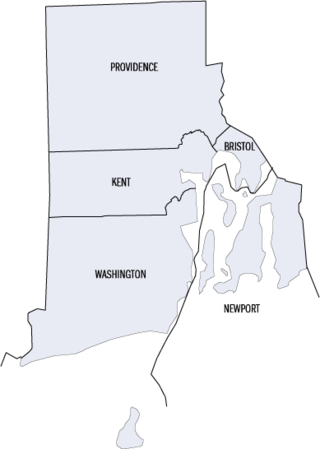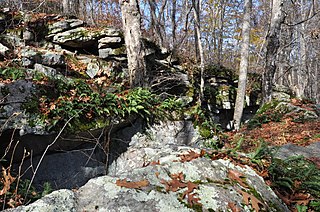Related Research Articles

This is a list of properties and districts listed on the National Register of Historic Places in Rhode Island. As of May 29, 2015, there are more than 750 listed sites in Rhode Island. All 5 of the counties in Rhode Island have listings on the National Register.

Folsom site or Wild Horse Arroyo, designated by the Smithsonian trinomial 29CX1, is a major archaeological site about 8 miles (13 km) west of Folsom, New Mexico. It is the type site for the Folsom tradition, a Paleo-Indian cultural sequence dating to between 11000 BC and 10000 BC. The Folsom site was excavated in 1926 and found to have been a marsh-side kill site or camp where 32 bison had been killed using distinctive tools, known as Folsom points. This site is significant because it was the first time that artifacts indisputably made by humans were found directly associated with faunal remains from an extinct form of bison from the Late Pleistocene. The information culled from this site was the first of a set of discoveries that would allow archaeologists to revise their estimations for the time of arrival of Native Americans on the North American continent.

The Gardiner Pond Shell Midden is a prehistoric archaeological site in Middletown, Rhode Island, named after George Gardiner who was an early settler in the area. The site includes a large shell midden, in which archaeological finds have been made dating the area's human habitation to the Middle and Late Woodland Period. Finds at the site include agricultural tools such as hoes, planting tools, and stone mortars and pestles. The midden is on the grounds of the Norman Bird Sanctuary.
The Hazard Farmstead is a historic archaeological site in Jamestown, Rhode Island. It is the location of a major American Indian settlement whose artifacts have been dated from 2,500 BC to 1,000 AD. It appeared to be occupied seasonally from late summer to fall, and was intensively used during those times.
Pine Hill Archeological Site, RI-655 is a prehistoric archaeological site on Prudence Island in Portsmouth, Rhode Island. The site's principal feature is a coastal shell midden dating to the Late Woodland period. Finds at the site include projectile points, stone tools, bones, and ceramics.

The Furnace Hill Brook Historic and Archeological District in a historic district in Cranston, Rhode Island.

The Sassafras Site, designated RI-55, is a prehistoric archaeological site in Albion, a village of Lincoln, Rhode Island. The site was discovered by archaeologists while surveying an area for a potential replacement for the Albion Street bridge, which spans the Blackstone River between Lincoln and Cumberland. The site encompasses a regionally significant quartz stone tool workshop.
The YWCA Site is an archaeological site in North Kingstown, Rhode Island.

The Jireh Bull Blockhouse is an historic archaeological site on Middlebridge Road in South Kingstown, Rhode Island. In 1657 a blockhouse was built on the site by Jireh Bull, son of Rhode Island Governor Henry Bull. The stone garrison house was burned by the Native Americans in King Philip's War on December 15, 1675, and fifteen soldiers defending the fort were killed. The site was acquired by the Rhode Island Historical Society in 1925.
The Nursery Site, RI-273 is a prehistoric archaeological site in Westerly, Rhode Island. Located near the Westerly Airport, this site has yielded evidence of Woodland Period stone tool work.

The Tomaquag Rock Shelters (RI-HP-1) are a prehistoric rock shelter site off Maxson Hill Road in Hopkinton, Rhode Island. The shelters are located under two east-facing granite outcrops in the valley drained by Tomaquag Brook. Nathan Kaye discovered the shelters in the late 1950s. Materials recovered from test excavations resulted in dating one shelter to 800 BC and the other to AD 800. Materials recovered include projectile points, stone knives, and evidence of stone tool construction. Both sites included evidence pointing to the presence of a fire pit.

Wyoming is a village and census-designated place on the Wood River in southern Rhode Island, primarily in the town of Richmond, Rhode Island, but extending north across the river into the town of Hopkinton, Rhode Island. The population was 270 at the 2010 census. It is the site of the Wyoming Village Historic District and a post office assigned ZIP code 02898.
The Carbuncle Hill Archaeological District encompasses a collection of archaeological sites in rural western Coventry, Rhode Island. Designated by the state as sites RI-1072 through RI-1079, this discontiguous cluster of sites has the potential to increase knowledge of prehistoric patterns of stone tool procurement, development, and use. The district was added to the National Register of Historic Places in 1985, primarily for its potential to yield further information.
The Greenwich Cove Site is a prehistoric archaeological site in Warwick, Rhode Island, US. The site is a significant multi-component site, with finds dating from the Late Archaic to the Middle Woodland Period. It notably includes a shell midden that has only been moderately affected by vandalism and development; these are particularly rare in coastal Rhode Island. The site was added to the National Register of Historic Places in 1980.
The Lambert Farm Site, designated RI-269, was a prehistoric archaeological site in Warwick, Rhode Island, United States. The site consisted of a large shell midden and a dispersed collection of associated stone artifacts at an inland location, which were dated to the Late Woodland Period. The site was examined by professional archaeologists in 1980, and was added to the National Register of Historic Places in 1983 for its potential to reveal information about prehistoric land use patterns. It was destroyed in 1991 by residential development of the area, although significant quantities of archaeological material were recovered prior to its destruction.
The Meadows Archeological District is a complex of four prehistoric archaeological sites in Warwick, Rhode Island. Discovered in 1980, the sites exhibit properties associated with the procurement and processing of stone tools. Three of the four sites include evidence of short-term habitation, and all four have shell middens. Occupation periods from the Archaic to the Woodland Period have been assigned to them. The district was added to the National Register of Historic Places in 1982, cited for its potential to yield new information about prehistoric Native patterns of living.

The Massachusetts Hornfels-Braintree Slate Quarry is a prehistoric archaeological site in Milton and Quincy, Massachusetts. It consists of a series of pits and trenches used from 7,000 B.P. until the early 17th century as a source of slate and hornfels used for chipped and ground tools. Pieces made from material quarried at the site are found over much of eastern Massachusetts. The site was added to the National Register of Historic Places in 1980.

The Summer Island site, designated 20DE4, is an archaeological site located on the northwest side of Summer Island, in Delta County, Michigan. It is classified as a stratified, multi-component site with Middle Woodland, Upper Mississippian and Early Historic/Protohistoric occupations. It was listed on the National Register of Historic Places in 1971.
The St. Croix River Access Site is a prehistoric Native American archaeological site on the St. Croix River in Stillwater Township, Minnesota, United States. It consists of a habitation site with a large quantity of stone tool artifacts, occupied from roughly 800 to 1700 CE. It was listed on the National Register of Historic Places in 1984 for having local significance in the theme of archaeology. It was nominated for its scientific potential to illuminate Late Woodland period cultural relationships, lithic technology, and resource use.
21SL55 is a precontact Native American archaeological site in the Boundary Waters of northern Minnesota, United States. It was occupied by the Blackduck culture of the late Woodland period sometime between 700 and 1500 C.E. Located on a small island in what is now Voyageurs National Park, the site is known only by its Smithsonian trinomial. It contains well-preserved faunal remains, a possible ricing jig, and other subsurface features.
References
- ↑ "National Register Information System". National Register of Historic Places . National Park Service. January 23, 2007.
- ↑ "Conference on New England Archaeology Newsletter, December 1984" (PDF). Retrieved December 11, 2016.